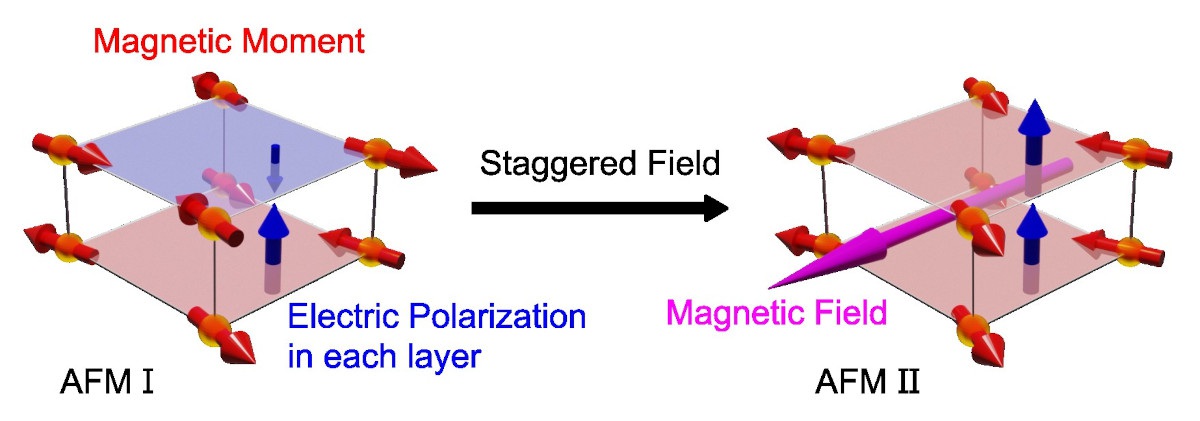Hidden Magnetoelectric Phase Transition by Emergent Staggered Magnetic Field
© The Physical Society of Japan
This article is on
Magnetic-Field-Induced Antiferromagnetic–Antiferromagnetic Phase Transition in Quasi-Two-Dimensional Multiferroic Material Ba2FeSi2O7
J. Phys. Soc. Jpn.
92,
014701
(2023)
.
Emergent staggered magnetic fields induce phase transition in the multiferroic material Ba2FeSi2O7.
This study established a design principle utilizing emergent staggered magnetic fields to obtain an enhanced physical response.

Magnetic fields are among the most fundamental external fields for manipulating the physical property of magnetic materials. Uniform magnetic fields induce phase transitions to obtain a gain from Zeeman energy, resulting in a metamagnetism characterized by transitions from antiferromagnets (AFMs) to ferromagnets. However, staggered magnetic fields, whose directions are antiparallel between neighboring magnetic atoms, remain relatively unexplored. In contrast to uniform magnetic fields, staggered magnetic fields potentially induce a phase transition between two distinct AFM phases, which is expected to accompany a jump in staggered magnetization.
An interesting application of this new type of phase transition is its usage as a knob for controlling composite order parameters in multiferroics. Multiferroics are a group of materials wherein multiple degrees of freedom, such as spin, charge, and lattice, are mutually coupled. They are considered a promising platform for realizing cost-effective next-generation devices. In multiferroics, unconventional spin degrees of freedom are known to be relevant to describe their unusual behavior. Certain types of staggered magnetic moments are considered to be responsible for ferroelectricity. However, the direct application of a staggered magnetic field in an experimental setup is challenging; this hinders the development of their functionality.
In this study, we observed a magnetic field-induced phase transition from a zero-field AFM phase to another AFM phase in the multiferroic material Ba2FeSi2O7. Consequently, the hidden role of the emergent staggered magnetic field was identified. A key ingredient is the Dzyaloshinskii–Moriya (DM) interaction of relativistic spin-orbit coupling origin, which exists in non-centrosymmetric materials, and facilitates effective conversion of the uniform magnetic field into a staggered magnetic field.
We measured the magnetic field dependence of magnetization and electric polarization of a single crystal Ba2FeSi2O7 and observed a phase transition accompanying electric polarization changes. Using a newly established spin model, the experimental observation was reproduced through mean-field numerical simulations. The simulation results indicate the jump in staggered magnetization at the phase transition, thus validating the proposed scenario. In other words, the phase transition is induced by the emergent staggered magnetic field converted from the applied uniform magnetic field through DM interaction. The fragile nature of the zero-field AFM structure against the emergent staggered magnetic field originates from the low dimensionality of this material, which enables the competition between exchange interaction and relatively weak DM interaction. Thus, our study demonstrated the utilization of the field-induced emergent staggered field to manipulate AFM phases and a design principle of materials.
(written by Y. Watanabe on behalf of all the authors.)
Magnetic-Field-Induced Antiferromagnetic–Antiferromagnetic Phase Transition in Quasi-Two-Dimensional Multiferroic Material Ba2FeSi2O7
J. Phys. Soc. Jpn.
92,
014701
(2023)
.
Share this topic
Fields
Related Articles
-
Higher-Order Topological Phases in Magnetic Materials with Breathing Pyrochlore Structures
Electronic structure and electrical properties of surfaces and nanostructures
Magnetic properties in condensed matter
Mathematical methods, classical and quantum physics, relativity, gravitation, numerical simulation, computational modeling
2025-4-7
A simple example of a higher-order topological phase, in which the symmetry decreases step-by-step from the bulk to the corner, is realized in a magnetic system with a pyrochlore structure and is characterized by a series of quantized Berry phases defined for the bulk, surface, and edge.
-
Existence of Chiral Soliton Lattices (CSLs) in Chiral Helimagnet Yb(Ni1-xCux)3Al9
Magnetic properties in condensed matter
2025-4-1
Our study examines the magnetic structure of the monoaxial chiral helimagnet Yb(Ni1-xCux)3Al9, providing first direct evidence of the formation of chiral soliton lattice state.
-
Understanding Pressure-Induced Superconductivity in CrAs and MnP
Magnetic properties in condensed matter
2025-3-10
This study reviews existing research on the pressure-induced variation of magnetic properties of transition metal mono-pnictides like CrAS, MnP, and others, aiming to understand the unconventional superconductivity observed in CrAs and MnP.
-
Symmetry and AI: Building the Future of Physics Simulations
Magnetic properties in condensed matter
Measurement, instrumentation, and techniques
2025-2-18
Generative artificial intelligence (AI) has gained considerable attention in scientific fields. By embedding physical symmetry into AI before training, we created a faster and lighter model. Scaling improves the accuracy and unlocks the potential of physics research and applications.
-
Triangular Lattice Magnet GdGa2: Spin Cycloids and Skyrmions
Cross-disciplinary physics and related areas of science and technology
Electronic transport in condensed matter
Magnetic properties in condensed matter
2025-2-3
Careful measurements were conducted on the hexagonal magnet GdGa2 to reveal the experimental signatures of ultrasmall spin cycloids and of a potential Néel-type skyrmion lattice phase induced by a magnetic field.




